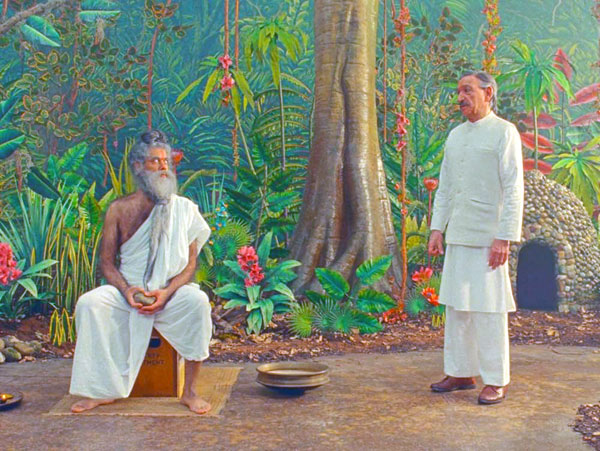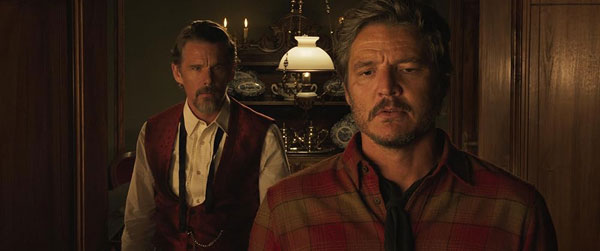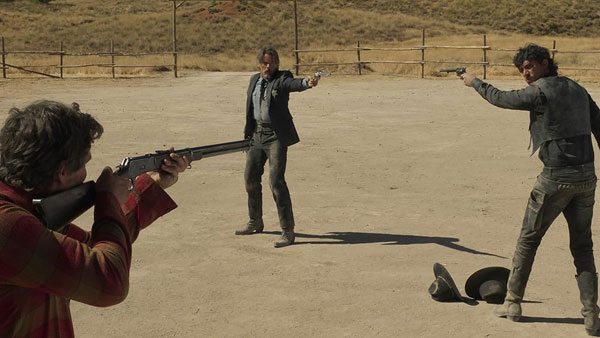|
Two
of the most renowned
living directors surprised
their fans in the past
year by releasing short
films. Both films,
which are now streaming on
Netflix, are masterful,
and each may rightfully be
considered a distillation
of its maker’s style
and artistic concerns.
Clocking in at forty-one minutes, The Wonderful Story of Henry Sugar is
Wes Anderson’s
second adaptation of a
Roald Dahl story, after
his stop-action animation The Fantastic Mr. Fox. It
begins in the
writer’s hut at
Gipsy House, Dahl’s
estate in Buckinghamshire,
as Dahl (Ralph Fiennes)
cleans his writing board,
sharpens his pencils, and
assembles the coffee,
cigarettes, and chocolates
he needs as aids to
writing. Then, he
starts telling the story
of Henry Sugar—a
pseudonym forced on him by
the protagonist’s
family, he explains.
Henry Sugar (Benedict
Cumberbatch) is a wealthy
nonentity.
“Men like Henry
Sugar are found to be
drifting like seaweed all
over the world,”
Dahl tells us.
“They are not
particularly bad men, but
they are not good men
either. They are
simply part of the
decoration.”
Henry has one passion:
gambling. One rainy
afternoon at a
friend’s country
estate, a bored Henry
rummages through his
host’s massive
library. He
discovers a report by Dr.
Chatterjee (Dev Patel), a
physician in Kolkata who
wrote of his encounter
with Imdad Khan (Ben
Kingsley), a music hall
performer who claimed he
could see without using
his eyes. After
various experiments, Dr.
Chatterjee realized that
Imdad told the truth.

Imdad told Dr. Chatterjee of his meeting with The Great Yogi (Richard
Ayoade), who revealed to him the mental exercises necessary to
achieve eyeless sight. Dr. Chatterjee recorded the exercises in detail,
which intrigues Henry—not least because one of the experiments was
reading the faces of playing cards from the back. If he can train
himself to do that, he thinks, he can make millions at blackjack. (Men
like Henry Sugar, Dahl reminds us, are never so rich that they don’t
want more.)
Those with even slight knowledge of Dahl’s work will suspect at this
point that Henry will come to a bad end. The film even provides a bad
end for him—and then rejects it for something more imaginative and
more delightful. The Wonderful Story of Henry Sugar is, in fact,
delightful in every way. The trademark artificiality of Anderson’s style
is apotheosized here, with stagehands changing the brightly painted
backdrops that look, appropriately, like illustrations in a children’s
book. Robert D. Yeoman and Adam Stockhausen, Anderson’s usual
cinematographer and production designer, make the colors and images
swirl kaleidoscopically.
The actors enter totally into the spirit of the story. Always facing the
audience, they deliver their monologues (for there is little in the script
that can be considered dialogue) in a crisp, rapid flow resembling a
non-musical version of a Gilbert and Sullivan patter song. This is all
the better to convey Anderson’s, and Dahl’s, message in Henry Sugar, which is worldly-wise yet optimistic, joyous but not childish. Anderson
and Dahl show us that even selfish people doing selfish things can
experience a moment of enlightenment that will change their lives, and
the world, forever.
Almodovar’s Strange Way of Life, a gritty and ostensibly traditional
Western, is far removed from the enchantment of The Wonderful Story
of Henry Sugar. It is equally far removed from the pessimism of the
most famous gay Western, Brokeback Mountain. Given both its
brevity and its high production quality, the thirty-one-minute Strange
Way of Life resembles the best episode of Death Valley Days ever
made—although it’s a hoot imagining how Ronald Reagan would have
introduced it.

Almodovar begins Strange Way of Life in a way familiar to Western
fans: Silva (Pedro Pascal) rides his horse across the desert to the tune
of a sultry contralto voice singing in Spanish. The familiarity ends
within seconds when we see the singer: a willowy young countertenor
(Manu Rios) with a day’s growth of beard, strumming his guitar.
In town, Sheriff Jake (Ethan Hawke) is choosing a coffin for the
recently murdered widow of his brother and planning the capture of
her suspected murderer. Silva walks into his office. He and Jake are
obviously happy to see each other. They share a meal and a bottle of
wine; the film cuts to the next morning, with Jake in the bathtub and
Silva lying bare-buttocked in Jake’s bed.
Jake and Silva’s conversation, so friendly the night before, quickly
turns heated. It turns out that Silva’s outlaw son Joe (George Steane) is
the suspect in the murder. Silva wants Jake to let Joe escape, but even
more he wants to resume the love affair he and Jake had twenty-five
years before, when they were gunslingers together.
Jake likes his respectable new life as a sheriff, and he wants to honor
his promise to his dead brother to do right by his widow. He is not
receptive to either of Silva’s propositions, and in a rage he draws his
gun.
“How will you explain this?” Silva asks. “A half-undressed man in your
bedroom, still smelling of cum?”

With the aid of his usual cinematographer and composer, Jose Luis
Alcaine and Alberto Iglesias, Almodovar once again uses traditional
Hollywood tropes only to upend them. Ethan Hawke and Pedro Pascal
are believably hard-bitten as Jake and Silva, and, even more, they
make a sexy couple.
In using the Western genre, Almodovar goes Ang Lee one better,
creating an ending for Jake and Silva that less resembles Brokeback
Mountain than Todd Haynes’ Carol or even James Ivory’s Maurice. In Strange Way of Life, there is at least a chance for happiness.
|